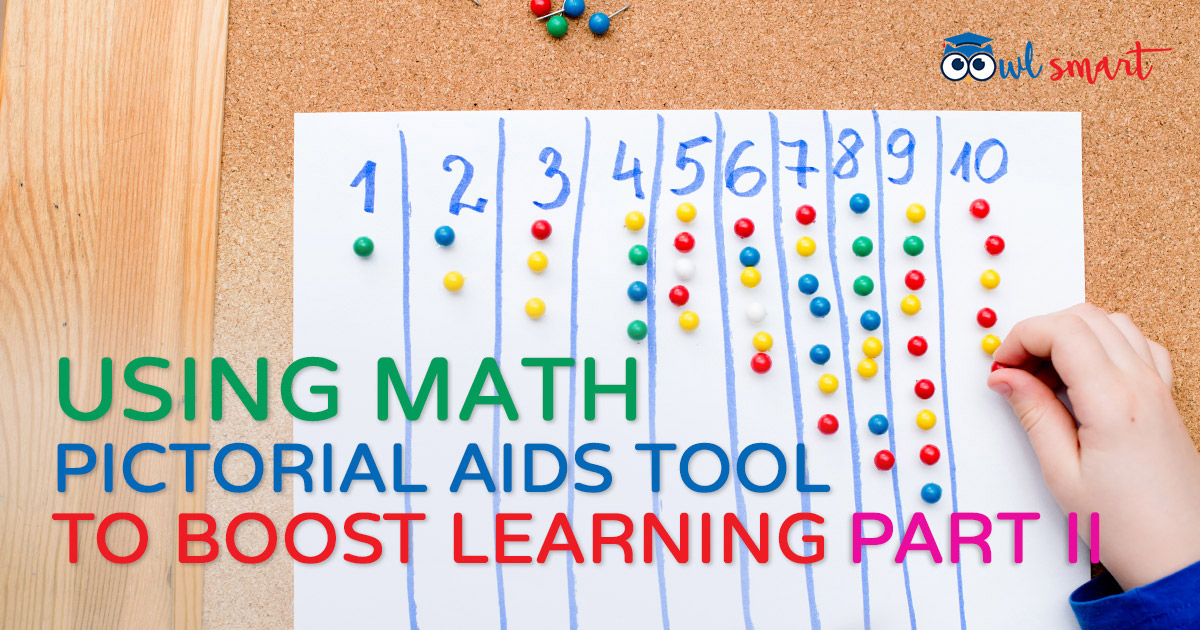
This article is the second in the series of usefulness of pictorial aids in teaching Math. You might want to read the first article if you have not.
As mentioned, many students require the use of pictures to help them in visualising and understanding Math concepts. This is especially so for lower primary kids.

Once a child is familiar with a Math concept, he can move on to abstract questions and will not need the aid of pictures to help in solving the question anymore.
Here, I will share with you more examples on the usage of pictures and diagrams in helping your child to learn Math more easily.
Example 1 (P1)
Bob has 7 sweets. Cindy has 3 sweets. How many sweets must Bob give to Cindy so that they have the same number of sweets?
Tip : Draw the number of sweets as shown below to help your child visualise better.

Bob must give Cindy 2 sweets so that they have the same number of sweets.
From the above example, we can see clearly that Bob has 4 more sweets (circle in green) than Cindy. To have equal number of sweets, Bob has to give two sweets (circle in green) to Cindy.
Example 2 (P2)
Ramesh has 36 pencils. If he puts 3 pencils in a container, how many containers does he need?

36 ÷ 3 = 12

He needs 12 containers.
From the above example, you can circle the pencils in groups of 3. Visually, your child can see clearly that 36 ÷ 3 = 12.
For the questions in OwlSmart Math database, we have added in doodling tools so that your child can circle objects in groups as shown above or do some working.
Example 3 (P3)
Aunt Jane bought 342 eggs. Uncle Lim bought 58 eggs more than her. How many eggs did Uncle Lim buy?
342 + 58 = 400

Uncle Lim bought 400 eggs.
The above example uses another visual aid, models, to show that Uncle Lim has more eggs than Aunt Jane. Thus, we need to add the two values to find out how many eggs Uncle Lim had. Basically, we can use models when you see phrase like” more than” or “less than” in a question.
Example 4 (P3)
Which fraction is bigger?

Needless to say, the comparison of the two pictures show clearly that 1/2 is definitely bigger. A part for a pie cut into two equal parts is bigger than a part of a pie cut into 4 equal parts.
Example 5 (P4)
Shawn has $185 more than Ali. Ali has 4/9 as much money as Shawn. How much do they have altogether?

5 units = $185
1 unit = $185 ÷ 5 = $37
13 units = $37 x 13 = $481
Ans: $481
Based on the fraction 4/9, Ali has 4 units while Shawn has 9 units. We can draw the number of units each person has using models. Since Shawn has $185 more than Ali, the extra 5 more units Shawn has than Ali must be equal to $185. A model shows the concept of “more than” and number of units each person has very clearly here.
Conclusion
The few simple examples shown are commonly used in schools to help your child visualise concepts. For upper primary students, pictorial aids like models are often used to help your child visualise and simplify complex problem sums.
For more practice on questions with diagrams and pictures, do get a subscription with OwlSmart so that your child can learn fundamental concepts more easily. As the saying goes “Practice makes perfect”.
About the Author
Teacher Zen has over a decade of experience in teaching upper primary Math and Science in local schools. He has a post-graduate diploma in education from NIE and has a wealth of experience in marking PSLE Science and Math papers. When not teaching or working on OwlSmart, he enjoys watching soccer and supports Liverpool football team.



